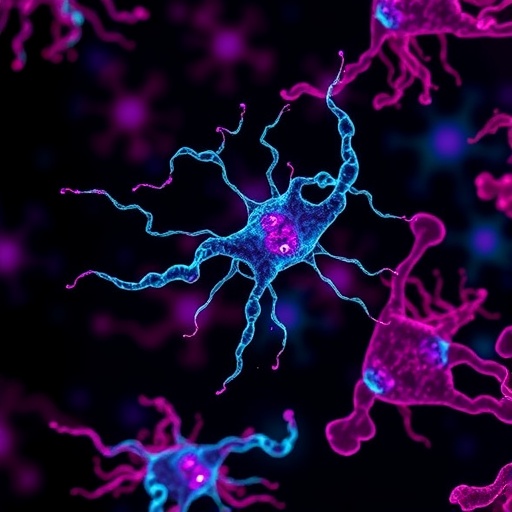
Breast Cancerâs Deadly Bone Metastases: Unlocking the Metabolic Hijacking Behind Anemia and Tumor Survival
Breast cancerâs proclivity to spread to the bone marks a grim turning point in patient prognosis, framing a metastatic niche that is notoriously resistant to conventional therapies. These secondary tumors not only jeopardize skeletal integrity but also provoke systemic complications, among which anemiaâa deficiency in bloodâs oxygen-carrying capacityâstands out as a debilitating yet poorly understood consequence. While anemia in metastatic breast cancer had long been attributed principally to bone marrow disruption, the precise mechanistic underpinnings remained largely elusive. Recent groundbreaking research spearheaded by Yibin Kang and Yujiao Han at the Princeton Branch of the Ludwig Institute for Cancer Research now illuminates the sophisticated interplay between cancer cells and the bone marrow microenvironment that drives both tumor progression and anemia.
The metastatic bone niche presents a harsh milieu marked by hypoxia and scarce nutrient availability, challenging the survival of disseminated tumor cells. To overcome these constraints, metastatic breast cancer cells have evolved remarkably versatile strategies. Kang, Han, and their colleagues employed meticulous cellular and molecular analyses to dissect how these cancer cells manipulate specialized bone marrow components to extract metabolic support vital for their growth. Their findings, detailed in the prestigious journal Cell, reveal a dual mechanism by which breast cancer cells subvert normal hematopoietic processesâdirectly impairing red blood cell production and simultaneously enhancing their own survival capacity within the oxygen-deprived marrow.
Crucial to this malignant adaptation is the exploitation of erythroblast island (EBI) macrophages, a specialized subset of immune cells embedded in the bone marrow niche. Under physiological conditions, EBI-macrophages serve a nurturing role, recycling iron and supplying it to erythroblastsâthe precursors of red blood cellsâfacilitating hemoglobin synthesis crucial for oxygen transport. However, the research unveils that metastatic breast cancer cells âhijackâ these macrophages to reroute iron resources exclusively to themselves. This metabolic commandeering deprives erythroblasts of iron, undermining effective erythropoiesis and precipitating anemia. Han emphasizes this point, noting that experimental depletion of EBI-macrophages in murine models significantly curtailed breast cancer bone metastases, underscoring their centrality in tumor sustenance.
Beyond mere iron scavenging, metastatic tumor cells also demonstrate phenotypic plasticity by mimicking erythroblast-like characteristics. One astonishing discovery in this study is the aberrant expression of β-globin, a hemoglobin subunit typically restricted to red blood cells, by metastatic cancer cells in the hypoxic marrow environment. This ectopic β-globin expression is hypothesized to confer a survival advantage by enhancing intracellular oxygen handling and mitigating oxidative stress, an adaptation that correlates strongly with increased bone metastasis risk in human clinical samples. The researchers propose that this form of âmolecular mimicryâ is a critical facet enabling cancer cells to thrive where oxygen is limited.
The synergy of these two strategiesâmetabolic hijacking of EBI-macrophages to monopolize iron and the adoption of erythroid properties to endure hypoxiaâcreates a pernicious feedback loop. Iron acquisition fuels tumor proliferation while simultaneously starving erythroblasts of a vital hematopoietic substrate, exacerbating anemia in patients. This disruption of normal bone marrow function elucidates a heretofore obscure axis of tumor-immune-metabolic cross-talk integral to metastatic progression. Kang elaborates that this discovery not only deepens fundamental understanding of bone metastasis biology but also paves the way for therapeutic interventions aimed at decoupling tumor growth from marrow dysfunction.
Intriguingly, the phenomenon of EBI-macrophage hijacking appears to transcend breast cancer, with analogous observations in bone metastases arising from lung and kidney carcinomas. This suggests a conserved metastatic strategy among diverse solid tumors colonizing the bone microenvironment. Given the prevalence of cancer-induced anemia and the clinical challenges it poses, targeting the metabolic interactions between tumor cells and the bone marrow niche holds considerable promise. Disrupting these pathological iron fluxes or impeding β-globin expression could restore erythropoiesis while stifling tumor expansion.
From a translational perspective, these insights highlight novel biomarkers and molecular targets. Elevated β-globin in tumor cells could serve as a prognostic indicator for bone metastatic potential. Furthermore, therapies designed to modulate EBI-macrophage function may protect hematopoietic integrity without compromising anti-cancer efficacy. Such approaches align with the emerging paradigm of metabolic vulnerability exploitation, supplementing existing modalities focusing on genetic and immunologic tumor characteristics.
The study by Kang and Han exemplifies the integrative research paradigm bridging cellular biology, immunology, and cancer metabolism. By deploying a combination of in vivo models, patient sample analyses, and cutting-edge molecular profiling, the team elucidated the sophisticated ecological niche created by metastatic cells within bone marrow. Their work underscores the remarkable plasticity of metastatic cells, adept at remodeling their immediate environment to their advantage through metabolic and phenotypic reprogramming.
As therapies evolve to meet the challenges of metastatic disease, unraveling such complex tumor-host interactions becomes imperative. Anemia, often overshadowed by other clinical concerns, is now recognized as a direct consequence of tumor biology rather than merely a byproduct of bone marrow damage. Addressing these mechanisms could profoundly impact patient quality of life and survival outcomes, a dual victory in the battle against metastatic breast cancer.
This research was supported by a consortium of philanthropic and scientific foundations including the Ludwig Institute for Cancer Research, American Cancer Society, and Susan G. Komen Foundation. Yibin Kang, beyond his membership at the Ludwig Institute, holds the prestigious Warner-Lambert/Parke-Davis Professorship at Princeton University and serves as Associate Director at Rutgers Cancer Institute of New Jersey, underscoring the institutional commitment to advancing metastatic cancer research.
In conclusion, the unveiling of tumor-driven metabolic manipulation within the bone marrow niche sheds critical light on how breast cancer metastasis undermines normal physiology, particularly red blood cell production, through iron theft and erythroid mimicry. This discovery not only expands the conceptual framework of metastatic adaptation but also opens new therapeutic vistas aimed at disrupting the lethal synergy between tumor progression and cancer-associated anemia.
Subject of Research: Metabolic interactions between metastatic breast cancer cells and the bone marrow microenvironment leading to anemia and tumor proliferation.
Article Title: Breast Cancer Metastases Exploit Bone Marrow Iron Recycling and Erythroid Mimicry to Promote Anemia and Tumor Survival.
News Publication Date: September 3, 2025.
Web References:
Ludwig Institute for Cancer Research: https://www.ludwigcancerresearch.org/scientist/yibin-kang/
Original article in Cell: https://www.cell.com/cell/abstract/S0092-8674(25)00927-4
References: Available upon request from Ludwig Cancer Research publications.
Image Credits: Ludwig Cancer Research (Photo of Yibin Kang).
Keywords: Breast cancer, bone metastasis, anemia, erythroblast island macrophages, iron metabolism, β-globin expression, tumor microenvironment, metabolic adaptation, erythropoiesis disruption, metastatic progression, cancer metabolism, hematopoiesis, tumor-immune interaction.
Tags: anemia in metastatic breast cancerbone marrow microenvironment and cancerbone metastases in breast cancercancer cell manipulation strategieshypoxia in metastatic nichesinnovative cancer research breakthroughsmechanisms of tumor progressionmetabolic hijacking in tumorsnutrient scarcity in cancer growthsystemic complications of bone metastasestherapeutic resistance in metastatic cancertumor survival strategies




